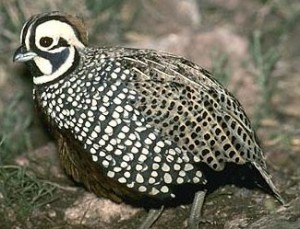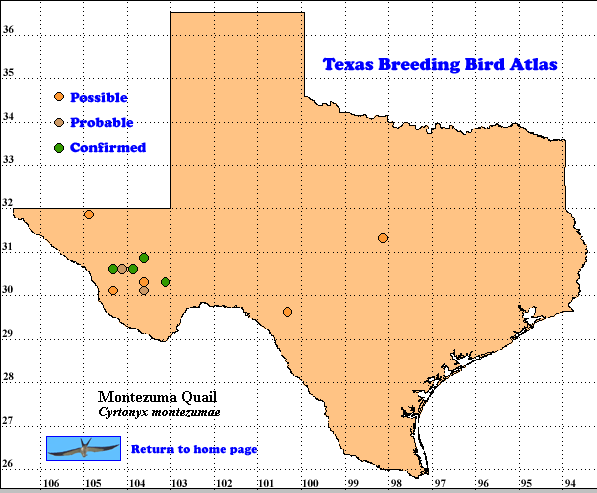Montezuma Quail is a quiet, secretive bird with sexually dimorphic plumage (the female is a much duller version of the male). The birds crouch or move away on the ground rather than flying when disturbed. This behavior makes censusing this quail difficult without the use of trained dogs. In their favored habitat of open, grassy woodlands, these birds use an area as small as 1-2 ha (2.5-5 acres) where they feed primarily on acorns and underground tubers. (Stromberg 2000).
DISTRIBUTION. Two populations occurred historically in Texas, one on the Edwards Plateau in an area bounded roughly by Nolan, Burnet, Bexar and Val Verde counties, the other in the mountains of the Trans-Pecos region. The two populations were connected across the Stockton Plateau.
This species survives today on the Edwards Plateau in Edwards, Real, Kinney and Val Verde counties. TBBA atlasers found possible breeding evidence for this secretive bird in latilong blocks 29100 and 31098 in this region. The species also survives in the Davis, Del Norte, Glass and Guadalupe mountains of the Trans-Pecos (Albers and Gehlbach 1990, Wauer 1996, L. Henderson, pers. comm.). In the Trans-Pecos TBBA investigators found 3 possible breeding records in latilong 31104 and one confirmed, 3 probable and 2 possible records in 30104; 3 confirmed, 4 probable and a possible in 30103. Since each quail is a permanent resident in a small area, all records may represent breeding populations.
In 1981-1982 eight quail/km2 (21/mi2) was the average density in year-round studies on a moderately-grazed ranch. In comparison the average density on a nearby un-grazed ranch was 10/km2 (26/mi2) at 500 m (1650 ft) in Edwards County (Albers and Gehlbach 1990). Estimates in the summer of 1970 were 6/km2 (16/mi2) on ranch land at 2100 m (6900 ft) and 18/km2 (47/mi2) in the un-grazed Davis Mountains State Park at 1550 m (5000 ft), Jeff Davis County (FRG). This data is comparable to that from the Huachuca Mountains in Arizona and Sierra Madre, Chihuahua, Mexico of 9-10/km2 (23-26/m2i; Leopold and McCabe 1957).
Elsewhere Montezuma Quail are resident at mid-elevations in Arizona and New Mexico and south in the Sierras of mainland Mexico to the Isthmus of Tehuantepec (Howell and Webb 1995, Stromberg 2000).
SEASONAL OCCURRENCE. Montezuma Quail are year-round residents of their breeding habitat. Egg-laying starts in late May (Van Tyne and Sutton 1937) and probably peaks in mid-June. Chicks hatch in mid-July at the time of the summer rainy season (Leopold and McCabe 1957). By contrast the geographically and reproductively distinct Edwards Plateau population lives in a spring to early summer rainfall regimen, where chicks hatch in mid-June. This bird is single brooded, but re-nesting after egg loss may occur so half-grown chicks have been seen as late as mid-September on the Edwards Plateau (Albers and Gehlbach 1990).
BREEDING HABITAT. Montezuma Quail breed in oak-juniper and pine-oak-juniper woodlands with grassy openings (Leopold and McCabe 1957, Albers and Gehlbach 1990). At least 60% of the ground cover must be
grasses at least 0.3 m (1 ft) tall. This quail disappears when grazing removes tall grasses, because the birds require them for cover and nesting (Brown 1982, Albers and Gehlbach 1990). Nests are built on the ground beneath bunch grasses using grasses for the cup and roof (FRG). Other sites used are under a cactus clump (Van Tyne and Sutton 1937) or in grass against a tree (Leopold and McCabe 1957).
On the Edwards Plateau factors positively impacting this species are tall bunch grasses as a high proportion of ground cover, fewer shrubs than in areas where this was extirpated, steeper slopes, greater soil depth and less soil moisture (Albers and Gehlbach 1990).
This quail often builds a covered chamber of grasses and leaves woven together for stability, 13-15 cm (5-6 in) inside diameter and 10-13 cm (4-5 in) high. An average clutch is 11 (range 2-15) smooth, somewhat glossy, white, unmarked eggs. Both sexes incubate the eggs for about 24-26 days and the young leave the nest after the full clutch has hatched.They remain with the parents for 6-7 months (Stromberg 2000).
STATUS. Oberholser (1974) mapped 23 certain historical and 32 total locations for Montezuma Quail in Texas/, whereas there are only 6 now. This species now occupies less than one percent of its historic range. This change is due entirely to habitat loss through removal of tall grass cover by overgrazing, augmented by drought, soil loss and shrub invasion.
This species was abundant in the Guadalupe Mountains in 1901 (Bailey 1928) but by the 1930s had declined there (Burleigh and Lowery 1940) and elsewhere in the Trans-Pecos (Van Tyne and Sutton 1937). It survived until about 1939 in the Guadalupes and 1964 in the Chisos Mountains (Wauer 1996). Montezuma introduced from Arizona persisted in the Guadalupes but survived only about 10 years in the Chisos (Wauer 1996. L. Henderson, pers. com.). The population on the Edwards Plateau disappeared rapidly in the 1930s to 1950s when overgrazing was widespread at a time of severe drought (E. Kincaid, pers. comm., FRG).By the early 21st century, Lockwood and Freeman (2004) described Montezuma Quail as uncommon and local in the Davis and Del Norte mountains and rare to locally uncommon in the Chinati and Glass mountains and Sierra Diablo and Sierra Vieja A relict population exists on the Edwards Plateau, centered in Edwards County.
Montezuma Quail is now considered a non-game species by the Texas Parks and Wildlife Department and an endangered species by the Texas Organization for Endangered Species as of 1988.
Text by Fredrick R. Gehlbach (Posted with updates 2006)
Literature cited.
Albers, R. P. and F. R. Gehlbach. 1990. Choices of feeding habitat by relict Montezuma Quail in central Texas. Wilson Bull. 102: 300-308.
Bailey, F. . 1928. Birds of New Mexico. NM Dept. Game and Fish, Albuquerque.
Brown, R. L. 1982. Effects of livestock grazing on Mearns in southeastern Arizona. J. Range Manage. 35: 727-732.
Burleigh, T. D. and G. H. Lowery, Jr. 1940. Birds of the Guadelupe (sic) Mountain region of western Texas. Occas. Papers, Mus. Zool., Louisiana State University 8: 85-151.
Howell, S. N. G. and S. Webb. 1995. A guide to the birds of Mexico and northern Central America. Oxford University Press, New York.
Leopold, A. S., and R. A. McCabe. 1957. Natural history of the Montezuma Quail in Mexico. Condor 59: 3-26.
Lockwood, M. W. and B. Freeman. 2004. The TOS handbook of Texas birds. Texas A&M University Press, College Station.
Oberholser, H. C. 1974. The bird life of Texas. University of Texas Press, Austin.
Stromberg, M. R. 2000. Montezuma (Cyrtonyx montezumae). In The birds of North America, No. 524 (A. Poole and F. Gill, eds.). The Birds of North America, Inc., Philadelphia, PA.
Van Tyne, J. and G. M. Sutton. 1937. The birds of Brewster County, Texas. Univ. Michigan Mus. Zool., Misc. Publ. No. 37.
Wauer, R. W. 1996. A field guide to birds of the Big Bend, 2nd ed. Gulf Publish, Houston, TX.

